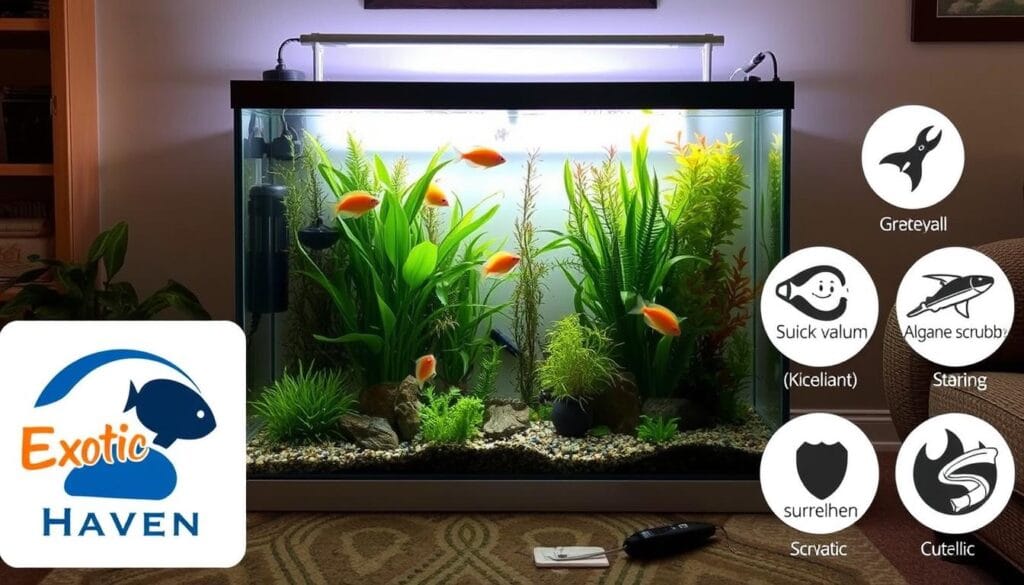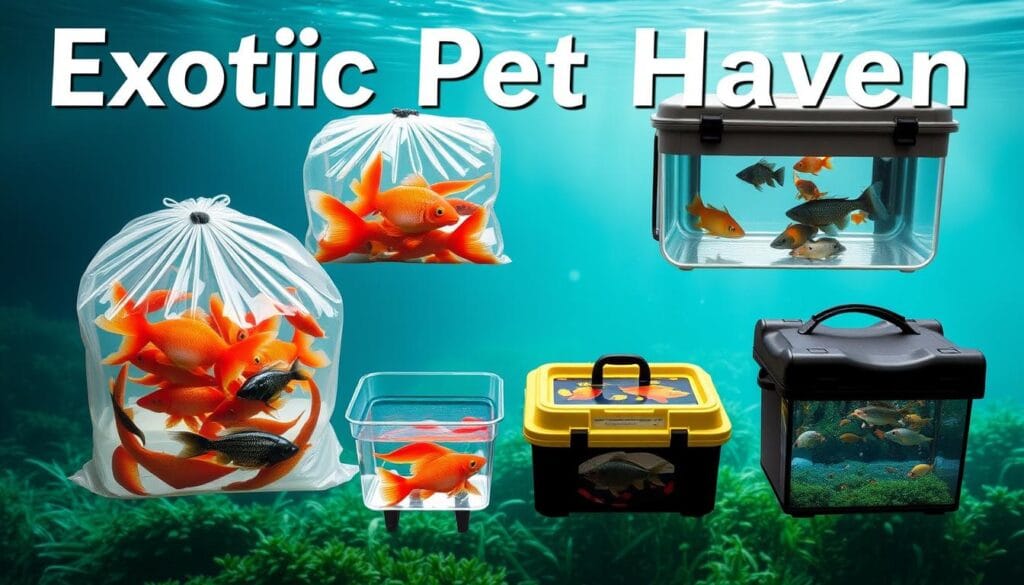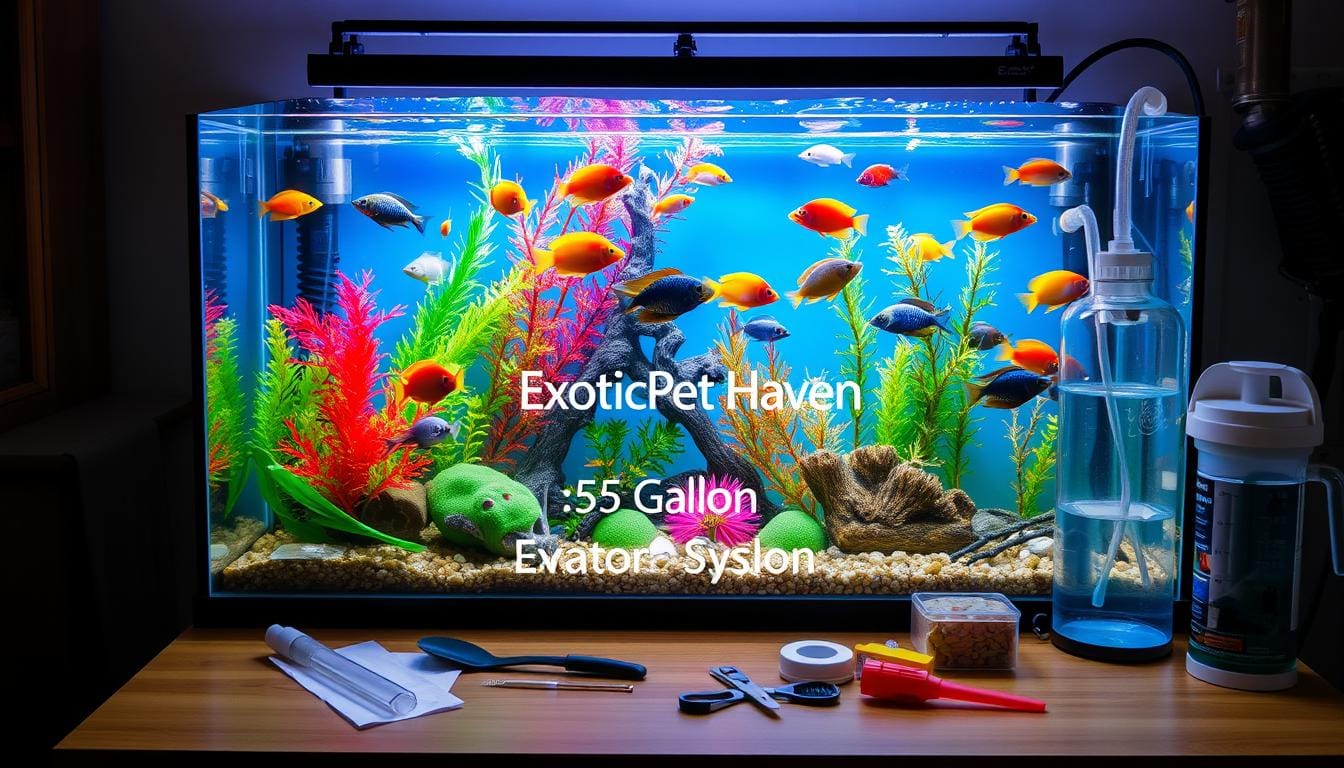When I first set up my 55 gallon fish tank, I learned it’s more than just water in a glass. It’s about creating a lively, thriving underwater world. This world needs dedication, knowledge, and careful attention.
Maintaining a fish tank is both an art and science. Your 55 gallon tank is a delicate balance of water chemistry, equipment, and marine life care. Whether you’re new or experienced, knowing aquarium care is key to a healthy environment for your fish.
Good fish tank maintenance is more than just cleaning. It’s about understanding water parameters, choosing the right equipment, and following a consistent care routine. This ensures your fish stay healthy.
Table of Contents
Understanding the Basics of a 55 Gallon Fish Tank
Starting your aquarium journey means learning about your 55 gallon fish tank. This tank size lets you create a lively underwater world at home.
The standard 55 gallon tank is a big space for your fish. It’s 48 inches long, 13 inches wide, and 21 inches tall. This gives you room for a colorful and diverse underwater community.
Choosing the Right Location for Your Tank
Finding the best spot for your 55 gallon tank is important. Consider these factors:
- Sturdy, level surface that can support up to 625 pounds when fully equipped
- Away from direct sunlight to prevent algae growth
- Close to electrical outlets for equipment
- Room temperature stability
Essential Equipment You’ll Need
To keep your 55 gallon tank healthy, you need certain equipment:
- Robust filtration system
- Reliable aquarium heater
- Accurate digital thermometer
- Appropriate lighting
- Quality substrate
Common Fish Types for 55 Gallon Tanks
Your 55 gallon tank can hold many fish species. Some popular ones are:
- Neon Tetras
- Guppies
- Corydoras Catfish
- Mollies
- Platies
“A well-planned 55 gallon tank can be a breathtaking centerpiece in any home aquarium.” – Aquarium Enthusiast
Pro tip: Follow the general stocking rule of 1 inch of fish per 1-2 gallons to maintain a healthy aquatic environment.
Setting Up Your 55 Gallon Fish Tank
Creating a perfect home for your fish needs careful planning. A 55 gallon fish tank setup has key steps for a healthy underwater world.
Preparing the Tank and Substrate
Start by cleaning the tank and substrate well. Here’s what to do:
- Rinse the tank with water (no soap)
- Use about 1 pound of gravel per gallon of water
- Spread the substrate evenly across the tank bottom
- Create gentle slopes for visual interest
Installing Filtration and Heating Systems
A good filter and heater are key for a stable environment. Here are some tips:
| Equipment | Specifications |
|---|---|
| Filter | Minimum 220 gallons per hour flow rate |
| 55 Gallon Fish Tank Heater | 3-5 watts per gallon capacity |
“A well-maintained aquarium is a window into an underwater world of beauty and tranquility.”
Adding Decorations and Plants
Turn your 55 gallon fish tank into a stunning scene with the right decorations and plants. Remember these tips:
- Choose aquarium-safe decorations
- Clean all items before placing them
- Create hiding spots for fish
- Balance looks with function
Pro tip: Live plants improve water quality and create a natural home for your fish.
Cycling Your Fish Tank
Aquarium cycling is key for a healthy 55 gallon fish tank. It gets your tank ready for fish by creating good bacteria. These bacteria help break down waste.
Knowing about aquarium cycling is important. It keeps your water and fish healthy. Nature automatically cycles 99.9% of aquariums, but you can make it better.
What is Tank Cycling?
Tank cycling makes good bacteria that turn bad stuff into safe stuff. These tiny helpers change ammonia to nitrites and then nitrates. This makes your tank a great place for fish.
- Establish bacterial colonies
- Convert toxic waste products
- Create stable water chemistry
How to Cycle Your Tank Properly
Experts say to cycle your tank without fish first. Start by adding a little fish food to make ammonia. Also, keep your filter running all the time.
| Cycling Stage | Duration | Key Actions |
|---|---|---|
| Initial Setup | 2 Weeks | Add fish food, run filter |
| Bacterial Growth | 4-6 Weeks | Test water parameters regularly |
| Stabilization | Ongoing | Monitor ammonia, nitrites, nitrates |
For more tips on cycling your tank, visit these expert fish care resources. They offer great advice on keeping your tank healthy.
Remember: Patience is key in aquarium cycling. Rush the process, and you risk your fish’s health.
Daily and Weekly Maintenance Tasks
Keeping a 55 gallon fish tank healthy needs regular care. It’s important to follow a routine for daily and weekly tasks. This keeps your tank vibrant and thriving.

Feeding Your Fish
Start your tank’s maintenance by thinking about how you feed your fish. Give them small amounts of food 1-2 times a day. Important feeding tips include:
- Feed only what they can eat in 5 minutes
- Take out any uneaten food right away to keep the water clean
- Change their diet with different high-quality foods
- Don’t overfeed, as it can harm the water quality
Observing Fish Behavior
Watching your fish every day is key to spotting health issues early. Look out for signs like:
- Strange swimming patterns
- Changes in color
- Less interest in food
- Any visible health problems
Basic Equipment Checks
It’s important to check your tank’s equipment regularly. Do these checks every week:
- Make sure the filter is working right
- Check the heater and the water temperature
- Look at the lighting systems
- Clean the filter media every month
“Consistent maintenance prevents 90% of common aquarium problems.” – Professional Aquarist
By spending time on these tasks, you’ll make a safe and healthy home for your fish. This will help your 55 gallon tank thrive for years.
Cleaning Your 55 Gallon Fish Tank
Keeping your 55 gallon fish tank clean is key for your fish’s health. Regular care makes sure your fish thrive and stay healthy. Cleaning your tank isn’t just about looks—it’s about making a good home for your fish.
Water Change Techniques
Changing the water in your tank is essential. Here’s how to do it right:
- Remove 10-20% of tank water weekly using a siphon
- Vacuum substrate to eliminate debris and waste
- Use dechlorinated water matched to tank temperature
- Pour new water slowly to minimize fish stress
Glass and Decoration Maintenance
To keep your tank clear, you need the right cleaning tools. Use these to keep your tank looking great:
| Cleaning Tool | Purpose | Frequency |
|---|---|---|
| Algae Scraper | Remove glass buildup | Weekly |
| Soft Brush | Clean decorations | Bi-weekly |
| Siphon | Substrate cleaning | Weekly |
“A clean tank is a happy tank” – Aquarium Enthusiasts Motto
Pro tip: Always rinse decorations in removed tank water to preserve beneficial bacteria. Avoid using soap or chemical cleaners that could harm your fish during aquarium cleaning.
Monitoring Water Parameters
Testing the water in your 55 gallon fish tank is very important. It helps keep your fish healthy. By checking the water often, you can stop problems before they start.
- pH levels
- Ammonia concentration
- Nitrite levels
- Nitrate percentages
Importance of Water Quality Parameters
Good water quality is key for your fish. They need stable conditions to stay healthy and avoid stress.
| Parameter | Ideal Range | Potential Impact |
|---|---|---|
| pH | 6.5 – 7.5 | Fish health and metabolism |
| Ammonia | 0 ppm | Toxic at high levels |
| Nitrites | 0 ppm | Harmful to fish respiratory system |
| Nitrates | Below 20 ppm | Indicator of biological filtration |
Tools for Accurate Aquarium Water Testing
Get good testing tools to check your tank’s water. Digital test kits and liquid systems give better results than simple strips.
“Consistent water testing is the key to a thriving aquarium ecosystem.” – Aquarium Experts
Digital thermometers and multi-parameter kits help you track your tank’s water well. Test your 55 gallon fish tank every week. Make small changes to keep the water stable.
Recognizing Common Fish Tank Problems
Knowing how to fix problems in your fish tank is key. Spotting issues early can stop them from getting worse. This helps keep your 55 gallon fish tank healthy.
Identifying Signs of Stress in Fish
Fish show stress in different ways. Look out for these signs:
- Erratic swimming patterns
- Loss of appetite
- Unusual color changes
- Hiding more frequently
- Gasping at water surface
Act fast if you see these signs. Stress can harm your fish’s health quickly.
Understanding Algae Growth
Algae is a big problem in fish tanks. Some algae is okay, but others can mean your water isn’t good.
“Green algae are typically harmless, while blue-green algae might signal poor water conditions.”
To fight algae, try these tips:
- Manage lighting duration
- Perform regular tank cleaning
- Monitor nutrient levels
- Introduce algae-eating fish species
Stay on top of aquarium issues to keep your tank thriving.
Handling Fish Transportation and Introduction
When you want to add more fish to your 55 gallon tank, you need a plan. Aquarium care is more than picking pretty fish. It’s about making sure they fit well in your tank.

Starting with the right steps is key. Fish need a smooth transition to your tank. This helps avoid stress and health issues.
Best Practices for Introducing New Fish
- Float the sealed fish bag in your tank for 15-20 minutes to equalize temperature
- Gradually add small amounts of tank water into the bag every 5 minutes
- Use a net to transfer fish, avoiding introducing bag water into the tank
- Quarantine new fish in a separate tank for 2-4 weeks to prevent disease spread
Tips for Safe Fish Transportation
Getting ready to move fish is crucial. Safe transport means being careful to avoid risks.
| Transportation Factor | Recommended Practice |
|---|---|
| Bag Selection | Use sturdy, oxygen-filled plastic bags |
| Pre-Transport Preparation | Stop feeding fish 24 hours before moving |
| Travel Duration | Minimize transport time |
| Temperature Control | Maintain stable water temperature |
Remember, patience and gentle handling are your best tools when introducing new fish to your aquarium environment.
“The key to successful fish transportation is minimizing stress and maintaining optimal conditions.” – Aquarium Experts
Troubleshooting Common Issues
Keeping a fish tank healthy is key. Even with the best care, unexpected problems can pop up. Knowing how to fix common issues quickly is vital for your tank’s health.
How to Fix Cloudy Water
Cloudy water is a sign of trouble in your tank. It can come from many sources:
- Bacterial bloom after initial setup
- Excessive fish waste
- Overfeeding
- Inadequate filtration
To clear up cloudy water, follow these steps:
- Do partial water changes (25-30%)
- Check and clean your filter
- Feed less
- Test water often
Dealing with Excessive Algae Growth
Algae can take over your tank, making it look bad and harmful. To control it, you need a few strategies.
| Algae Control Strategy | Recommended Action |
|---|---|
| Light Management | Reduce lighting to 6-8 hours a day |
| Nutrient Control | Keep phosphate and nitrate levels low |
| Biological Control | Add algae-eating fish or snails |
*”Prevention is always better than cure in aquarium maintenance.”*
Regular checks and early action are key to avoiding problems. By being proactive, you can keep your tank healthy and vibrant.
Resources for Further Learning
To learn more about 55 gallon fish tank care, check out quality aquarium resources. “The Simple Guide to Freshwater Aquariums” by David E. Boruchowitz is a great start. It offers deep insights into fish care and tank management.
Online platforms are great for connecting with seasoned aquarists. Sites like Aquarium Co-Op and Tropical Fish Hobbyist share expert tips and the latest in aquarium care. Reddit’s r/Aquariums and fishlore.com forums are also great places to ask questions and get advice.
Learning from experts and staying current with trends is crucial. It helps you master 55 gallon tank care. Remember, always keep learning and practicing to become a pro at aquarium care.
Recommended Books and Websites
Look for books and websites that are known for aquarium care. They should have detailed guides, troubleshooting tips, and advice for your tank.
Online Communities and Forums
Join online groups where aquarium lovers share their knowledge and experiences. These places offer real advice on handling aquarium challenges.

